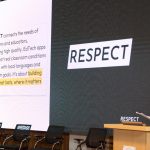March 21, 2021
Incorporating projects with K-12 students can be challenging at any time, and is especially difficult during a pandemic. This article focuses on a few tips from my book, Adventures in Authentic Learning: 21 Step By Step Projects from an Ed Tech Coach, published in December 2020. This book features guidance for implementing projects and helping students become lifelong learners.

Focus on the Learning and Not the Final Product
As educators, we often see project examples posted by educators on Pinterest and other social media platforms. Much like any other social media content, we should assume that these projects are “filtered’; i.e., heavily guided by teachers or parents. When implementing projects, if we focus on students creating a Pinterest-perfect final product, we lose sight of the real purpose…the learning.
Each time you are engaged in a project that is “failing”, I encourage you to consider what your students are learning. Ask yourself the following questions:
- Why do I think this project is failing?
- Even though this project isn’t turning out the way I expected it to, are the students learning more than they would during a traditional lesson?
- Can this “fail” turn into a learning opportunity for my students?
- What soft or other skills are students learning during this process?
If you can answer these questions and salvage a meaningful learning opportunity for your students, then congratulations, your project isn’t a fail! Sometimes when things get messy, this is when the best learning happens.
Assume Your Students Don’t Know
I often coach teachers who tell me that their students “aren’t good at cooperative learning”, or “can’t handle projects”. My response is usually that they probably need more guidance and practice. Most skills and activities associated with projects require critical thinking and a deeper level of content understanding. So whether students are brainstorming ideas, conducting research, or practicing a presentation, they will need teacher support. Students need clear guidelines, procedures, and models to help them successfully navigate cooperative projects.
Checklists and rubrics are a natural fit to help scaffold project activities for your students. Here are a couple of other ideas that I have found helpful for students in any grade or content area.
- Evaluate Students During Cooperative Tasks- I recommend implementing this during short cooperative activities before launching an in-depth project. To begin, focus on one group at a time and set a timer for two minutes. Focus on observing positive interactions, such as students accepting responses from their peers. Look for negative interactions as well, such as a student ignoring an idea from a peer. My book provides more examples and details about this, but the main goal is to give students feedback about how they interact with others. I have found that many students are amazed and didn’t realize they were ignoring or discounting ideas from other group members.
- Provide students with a model- Whether students are creating a presentation, poster, or video, it is beneficial to provide a model that clearly shows the expectations you have for their final product. One strategy I like to use is to show students a mediocre example and ask them to evaluate the example using the project rubric. Students of any age love the opportunity to act as a teacher, and this process helps students clearly understand the level of quality that you expect from them.
Be Flexible
One of my favorite things about implementing project-based learning is that it takes your lessons places that you never expected. Embrace this! Some of my most memorable classroom experiences were when projects didn’t go as planned, or when current events or other spontaneous learning opportunities arose and guided our day. One common challenge with a flexible classroom is how to fit everything in that we are expected to teach. To remedy this, let’s consider all the standards that are typically included in a spontaneous learning experience.
- Reading– If a unique bug or reptile joins your classroom for the day, this is a great time to incorporate some informational reading with your students. Find grade-level books or articles for students to read and learn more about the animal’s habitat, foods, and other valuable information to help you learn how to best care for your new friend.
- Research- If a new state or federal bill is passed, students can examine historical events they learned about and compare and contrast issues, or learn how historical events still affect current laws and issues. This requires valuable research skills such as Boolean searches, finding valid sources, and creating proper citations.
- Writing- Spontaneous classroom events can lead to a variety of writing opportunities for students. For example, if a corporation engages in a practice that harms the environment, students can write persuasive letters to express their thoughts and provide evidence urging them to consider their practices.
Other impromptu events or lessons can spark scientific investigations, math data collection, or opportunities to discuss historical perspectives and examine primary source documents. These experiences are some of the lessons your students will remember the most, so it is worth it to let your students guide their own learning and take time to explore the fun adventures that can happen when you allow for flexibility.
Kristin Harrington is an Educational Technology Coach and Media Specialist for Flagler County Schools. She is also an adjunct professor for Flagler College, and recipient of the 2020 ISTE Ed Tech Coaches Award. Click here to purchase her book on Amazon or in the ISTE store.










0 Comments